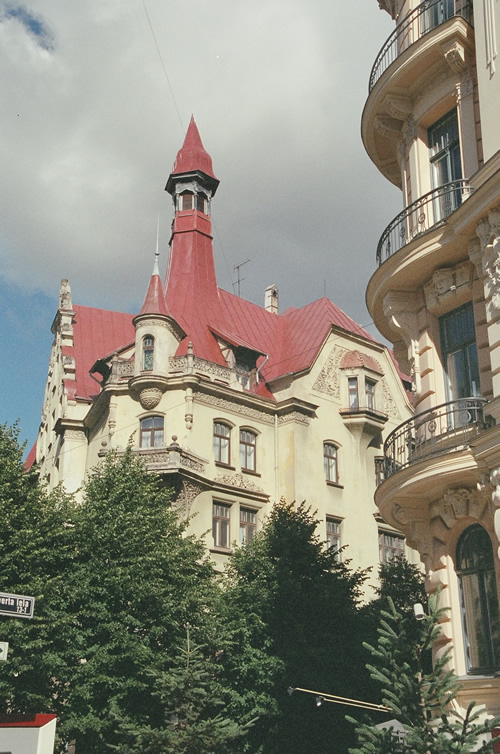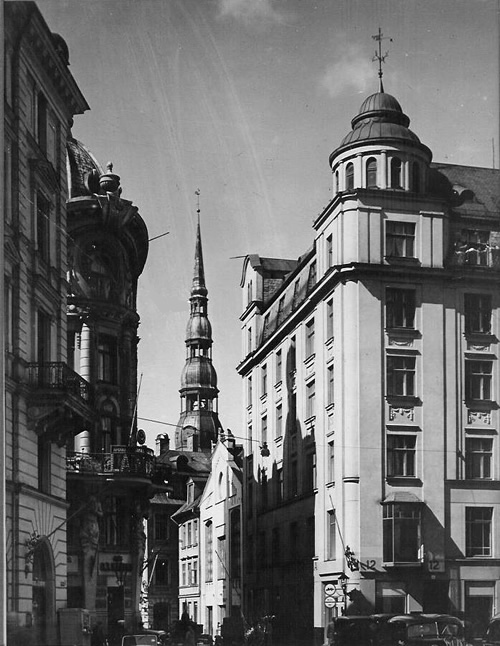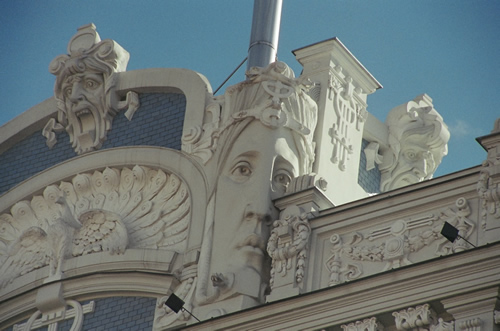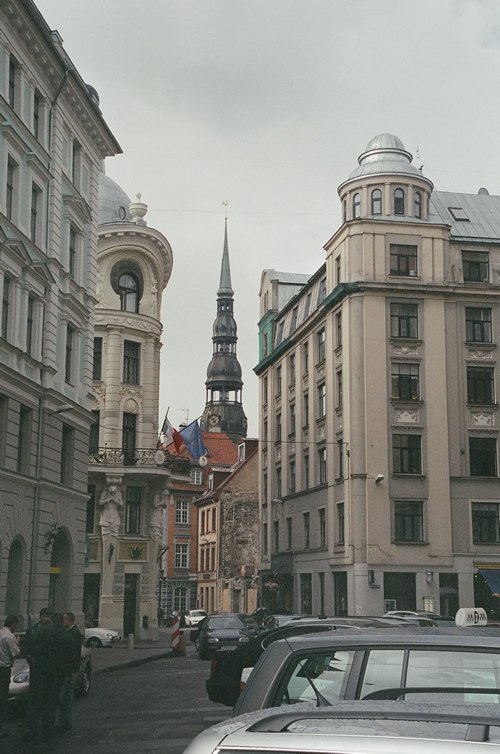Theater Street
in Riga, Latvia
Article and photos by Dominique Channell

|
|
Art Nouveau architecture in Riga, Latvia.
|
A striking girl in a clingy red dress dances on a café tabletop, strands of dark hair whipping around her head. The thick scent of beer rises as mugs clunk together on a tray, raucous chatter echoes in the alley, and the bars draw their doors wide to the evening streets like firm, outstretched arms. The main street of Kalku iela, in the Baltic city of Riga, Latvia, is absent of fear.
When I was very young I sought out Latvia on the world map and found it tucked under Estonia, that little spur from Russia in a threshold caught sometimes by Europe and sometimes by the Soviet Union. My mother never spoke Latvian in the house, because she thought it would be useless to me: after the Soviet and German invasions of World War II, her family had narrowly escaped deportation to Siberia by sailing to the U.S. as the Iron Curtain dropped over Eastern Europe. She could never have imagined any of us returning in her lifetime, and yet here I am, one of many Americans of my generation searching for my alter-identity — a foreign version of me, or what I could have been had my family remained. Rolling out the long “e” sounds from my phrasebook – Paldies, Labdien - I try to hear my mother's suddenly unfamiliar voice on the phone with my aunt when they wanted to talk in private. When she put down the receiver, her English was heavily accented for minutes afterward.
In Latvia in 2005, I am no more than a tourist, seeing everything for the first time. I’m holding a yellowed photograph. The picture has been creased and straightened out again; it is punctured in one place as though by a pen nib while someone had been carrying it in his pocket. The unidentified, ornate building where my grandmother lived is partially hidden from view, with a shop at street level and a prominent wraparound balcony above; electric bulbs spell out letters, but they are in shadow. The street curves away from the photographer, and in the channel of sky between the two sides of the street is a view of St. Peter’s Church. I have been walking a radius of the city around the distinctive triple-tiered steeple, measuring its height with my fingertips in the air to make sure that I’m the right distance from it – in the photo, it is only the height of a thumb. Any time now, I expect to look up and find the correct vantage. But many streets have changed, many buildings bulldozed.

|
|
Photo of the street in Riga from 1938.
|
Along the streets of Alberta, Elizabetes, and Strēlnieku the great early examples of Jugendstil, or Art Nouveau, rise up pale and tall out of the rubble, the smooth, stylized features of the embedded gargoyles flecked with the charcoal of diesel exhaust, dark brows and lips and chins on grayed plaster faces — monuments to progress, wealth, and ownership when pre-Soviet Latvia enjoyed prosperity as a port city. Most of the soot-stained buildings are vacant, with boarded-up first story windows; a tangle of electrical and telephone wires hangs slack overhead, and the street below has been torn up. The quiet, far from desolate, gives an effect of pause, of expectance: It appears someone has bought up the entire street. I imagine rows of hotels, sidewalk cafes, luxury apartments. As I walk back into the heart of the city, a Latvian child holding his mother’s hand stares at me with inquisitive eyes, lips parted.

|
|
Art Nouveau detail.
|
There appears to be no one who looks like me, no one with my square jaw and olive skin, features that come from my Czech father. Instead I see pale, heart-shaped faces, and among the heads of brown many shades of red hair; Russians, my mother tells me on the phone, long-distance. There are many Russians in Latvia now. Russian traditions have also made their way into Latvian life; Czarist customs such as the zakuska hour still take place in the early evenings, when savory hors d’oeuvres are enjoyed interspersed with tiny glasses of vodka.
I look at the photograph again. From each doorway protrudes a pole, readied for a flag, though no flags are flying. Two streetlamps might be converted gaslights, and a single electric light in a metal cap is strung high, held taut between one balcony and the wall opposite. There is a large wooden telephone box with one small window, like a confessional. Late-‘30s model cars, gleaming black and chrome, are parked curbside. A uniformed man appears to be inspecting a document while another leans in to see; two other figures, cloaked and hatted, are walking in the shadows, blurred by a slow shutter speed. A woman in a headscarf retreats into a shop. If I look at it long enough, I can create a story.
How do we know our history? We pin together the scattered still, static moments that are left to find a thread; we fetch out the icons that we recognize: the men in uniform, the film-noir shadows. In our effort to make sense of the past, we interpret and create connections, patterns — history repeats itself, in hindsight we are wiser — when the truth is that we can never really remember exactly what happened and why. For me, knowing what was to come next, the photograph has ominous portent; for my grandmother, it was a sunny day on a street she loved. Which of us has greater authority over the moment?
Walking through the ribbon of parkway that stretches along the Pilsetas canal, I pass the women selling small bunches of freesia; the flowers smell like sweet melon. Another vendor offers sklandrausis, pureed carrot and potato in round rye crusts. Before long, it is apparent that my search has taken me back to the starting point of my journey the day before, stepping off the bus outside of the Riga Opera House. From its steps, there is a long view of the park and the Freedom Monument, Riga’s own statue of liberty, marking Latvia’s independence on November 18, 1918; in a soaring, streamlined, upward thrust of stone, a woman holds an arc of three stars above her head, representing Kurzeme, Vidzeme and Latgale, Latvia’s three regions. Under Russian occupation she was officially renamed a memorial to the Soviet saviors of the city; now there are Latvian guards by her side.
Yesterday, I’d talked my way into a tour of the Opera House, winding my way through rooms that glowed with renewed opulence, everything polished and recently brought back to its former life: greens and golds and reds, triple balconies that gathered into the stage and brass numbered plates on the plush seats; a recital room with parquet floors and marble café tables; a lacquered wooden bar with glass flower lamps on the tables. It felt splendid but intimate and hushed, like the interior of a church. My tour guide, who might have been a stagehand, spoke no English. We communicated in gestures and he wrote down numbers in my notebook: 1,240 for the number of seats, 1863 for the date it was built. He led me through passageways full of costumes, pushing aside clouds of tulle and velveteen, and I thought of Riga as it must have been in its heyday, as the “Paris of the Baltics,” in the few precious years that followed its independence in 1918.
Looking away from the Opera House, I wait to cross Aspazijas Boulevard. And then I see St. Peter’s Church — the size of a thumb, a clock face at just the right angle: I am on Teatra iela, Theater Street, the match for the photograph.
|

|
|
Photo of the street in Riga in 2004.
|
Part of the building is visible in the photograph; a prominent 1903 Baroque and Art Nouveau-styled urban mansion. The life-sized figures on the front, holding up the balcony, are Athena and Hermeus, and three men, graceful in smooth white stone, bear the weight of Atlas from the top turret. The gloss-black globe they carry, larger than the men themselves, is made of glass and zinc. I see immediately my family’s status, my mother’s father, a prominent attorney with designs on the judiciary, hiding out in the forests during the summer of 1941 while his friends were hunted and arrested by Soviet forces just before the German invasion. But the building is filled with offices, offering no emotional cues. Can a place leave behind a historical or personal residue for those who are somehow connected with it, a memory or a confidence that resonates through the years and generations? How can we explain the sentimental longing for a thing that we are too young to have actually known?
The sky above Teatra iela looks like rain, but it seems a promise, not a threat. By nature interpretation is impressionist and momentary, like a photograph: We read whatever it is that we see on that wide blank canvas above, in each instant that we see it, and our frames of reference are always unique. I can’t tell her story, but I can tell mine.
|
Sources
on Latvia
Grava-Kreituse, Ilga, Inesis Feldmanis, Dietrich Andre Loeber and Juris Goldmanis. The Occupation and Annexation of Latvia 1939-1940. Documents and Materials. Riga, 1995.
Misiunas, Romuald J. and Rein Taagepera. The Baltic States. Years of Dependence 1940-1990. Berkeley, 1992.
Nollendorfs, Valters, ed. Latvijas Okupācijas muzejs: Latvija zem Padomju Savienības un nacionālsosiālistiskās Vācijas varas 1940-1991 Latvia under the Rule of the Soviet Union and National Socialist Germany. Rīga: OMF, 2002. [A bilingual history of the occupation.]
|
Dominique Channell
is a freelance writer and editor living in the San Francisco Bay Area. She earned her master's degree in writing and publishing, and has written for several travel publications.
|
